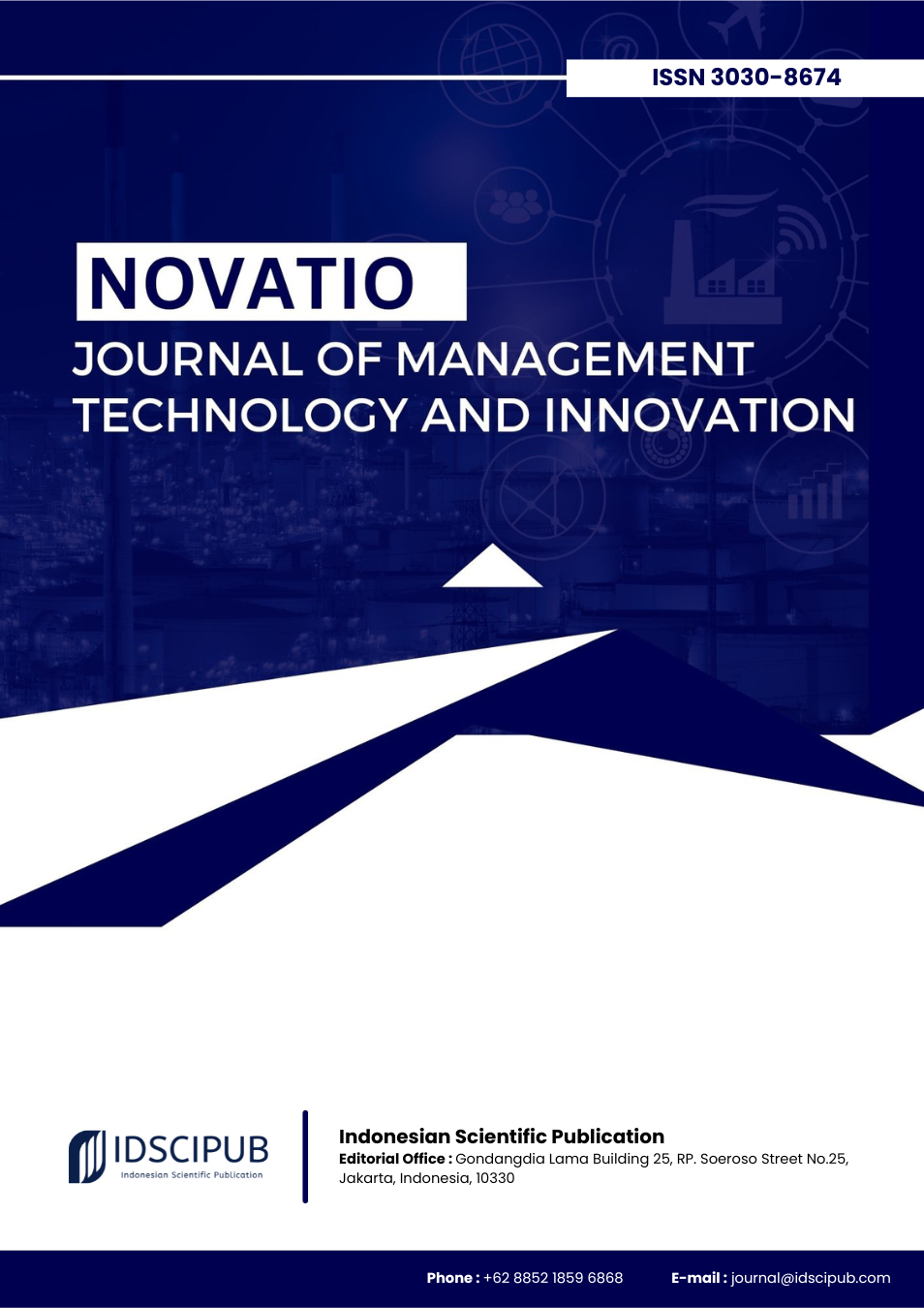Bridging Research and Digital Strategy: A Narrative Review of R&D–IT Integration
DOI:
https://doi.org/10.61978/novatio.v3i4.1030Keywords:
R&D Integration, IT Strategy, Digital Transformation, Innovation Management, Organizational Culture, Global Competitiveness, Cross-Functional CollaborationAbstract
The integration of research and development (R&D) with information technology (IT) strategies has become increasingly vital for high-tech firms in navigating global competition and rapid digitalization. This narrative review aims to evaluate how R&D–IT alignment influences innovation performance, organizational efficiency, and long-term competitiveness. A systematic narrative review approach was employed by analyzing peer-reviewed studies published in the last fifteen years that addressed R&D–IT interactions across various industries. The analysis focused on identifying key drivers, barriers, and systemic conditions shaping integration outcomes. Findings indicate that IT strategies consistently enhance R&D performance, demonstrated by increases in patent generation, shorter product development cycles, and improved customer satisfaction. Internal factors such as digital capabilities, transformational leadership, and innovation-oriented organizational culture further strengthen integration effectiveness. At the systemic level, supportive government policies, intellectual property protection, and stable regulatory frameworks provide enabling conditions for sustainable collaboration. Nevertheless, challenges including technological misalignment, cultural resistance, and limited infrastructure in developing economies remain significant obstacles. The implications of this review highlight the importance of policy incentives, workforce digital skill development, and stronger public–private collaborations to overcome systemic and organizational barriers. Future research should explore cultural and contextual dynamics in greater depth, particularly within emerging economies, to provide a more comprehensive understanding of how R&D–IT integration fosters sustainable innovation and competitiveness.
References
Belderbos, R., Lokshin, B., Boone, C., & Jacob, J. (2020). Top management team international diversity and the performance of international R&D. Global Strategy Journal, 12(1), 108-133. https://doi.org/10.1002/gsj.1395 DOI: https://doi.org/10.1002/gsj.1395
Cheah, S., Yang, Y., & Saritas, Ö. (2019). Reinventing product-service systems: the case of Singapore. Foresight, 21(3), 332-361. https://doi.org/10.1108/fs-12-2018-0107 DOI: https://doi.org/10.1108/FS-12-2018-0107
Chen, H., Cui, X., & Zhi, L. (2025). Research on the impact of digital-realistic integration to promote sustainable development of enterprises: based on the perspective of technology bias. Sage Open, 15(2). https://doi.org/10.1177/21582440251329725 DOI: https://doi.org/10.1177/21582440251329725
Furusawa, M. and Ishida, S. (2024). Integration strategy formulation of foreign-owned R&D subsidiaries. Management Decision, 62(12), 4148-4164. https://doi.org/10.1108/md-08-2023-1398 DOI: https://doi.org/10.1108/MD-08-2023-1398
Ho, J. and O’Sullivan, E. (2022). Toward integrated innovation roadmapping: lessons from multiple functional roadmaps beyond technology R&D. IEEE Transactions on Engineering Management, 69(1), 155-167. https://doi.org/10.1109/tem.2020.3029783 DOI: https://doi.org/10.1109/TEM.2020.3029783
Khan, I., Grover, V., Fatima, I., Alam, M., & Ahmad, N. (2024). The application of AI in drug discovery., 181-198. https://doi.org/10.4018/979-8-3693-5468-1.ch010 DOI: https://doi.org/10.4018/979-8-3693-5468-1.ch010
Kim, H., An, J., & Lee, C. (2023). Development of governance for an integrated public data (GIPD) framework: illustrative use of GIPD in South Korea. Aslib Journal of Information Management, 77(2), 213-238. https://doi.org/10.1108/ajim-12-2022-0531 DOI: https://doi.org/10.1108/AJIM-12-2022-0531
Květoň, V. and Horák, P. (2023). Firms’ supply chain integration, R&D collaboration, and impact on competitiveness: evidence from Czechia. Journal of the Knowledge Economy, 15(2), 5817-5840. https://doi.org/10.1007/s13132-023-01242-8 DOI: https://doi.org/10.1007/s13132-023-01242-8
Lei, S., Sun, C., & Ali, M. (2021). Role of servitization, digitalization, and innovation performance in manufacturing enterprises. Sustainability, 13(17), 9878. https://doi.org/10.3390/su13179878 DOI: https://doi.org/10.3390/su13179878
Liang, Z., Chen, Y., & Luo, M. (2017). Targeting stemness: implications for precision medicine in breast cancer., 147-169. https://doi.org/10.1007/978-981-10-6020-5_7 DOI: https://doi.org/10.1007/978-981-10-6020-5_7
Mendigorri, E., Valderrama, T., & Cornejo, V. (2016). Measuring the effectiveness of R&D activities. Management Decision, 54(2), 321-362. https://doi.org/10.1108/md-06-2014-0378 DOI: https://doi.org/10.1108/MD-06-2014-0378
Ndwiga, D., Ciera, L., & Mokabi, G. (2023). A conceptual appraisal towards the contextualization of product and process innovation in clothing manufacturing. Research Journal of Textile and Apparel, 28(4), 930-947. https://doi.org/10.1108/rjta-07-2022-0080 DOI: https://doi.org/10.1108/RJTA-07-2022-0080
Pu, T. (2025). Does digital transformation propel innovation strategies? An empirical investigation based on machine learning and the dynamic GMM approach. E+m Ekonomie a Management, 28(2), 81-96. https://doi.org/10.15240/tul/001/2025-5-012 DOI: https://doi.org/10.15240/tul/001/2025-5-012
Qiang, D., Zhang, L., & Huang, X. (2022). Quantitative evaluation of TOD performance based on multi-source data: a case study of Shanghai. Frontiers in Public Health, 10. https://doi.org/10.3389/fpubh.2022.820694 DOI: https://doi.org/10.3389/fpubh.2022.820694
Ramón-Jerónimo, M. and Herrero, I. (2017). Capturing firms’ heterogeneity through marketing and IT capabilities in SMEs. Sustainability, 9(12), 2180. https://doi.org/10.3390/su9122180 DOI: https://doi.org/10.3390/su9122180
Silva, P., Moutinho, V., & Oliveira, X. (2024). Digital transformation and entrepreneurship: a comprehensive perspective on the Nordic countries. European Journal of Innovation Management. https://doi.org/10.1108/ejim-04-2024-0374 DOI: https://doi.org/10.1108/EJIM-04-2024-0374
Velásquez-Duran, A. and Soledad, M. (2018). Research management systems: systematic mapping of literature (2007-2017). International Journal on Advanced Science Engineering and Information Technology, 8(1), 44. https://doi.org/10.18517/ijaseit.8.1.3307 DOI: https://doi.org/10.18517/ijaseit.8.1.3307
Xu, G., Shan, J., Li, C., Chen, X., & Zhou, N. (2023). Study on the innovation-driven effect of digital economy on real economy—a theoretical and empirical analysis from an R&D perspective. Sustainability, 15(21), 15370. https://doi.org/10.3390/su152115370 DOI: https://doi.org/10.3390/su152115370
Yunlin, M., Chunmao, C., Sun, X., Wen, Y., Zhongai, W., Congquan, Z., … & Zhao, R. (2024). Research on quality management strategy of automotive software based on agile iteration., 16. https://doi.org/10.1117/12.3052273 DOI: https://doi.org/10.1117/12.3052273
Zhong, Z. and Zhao, E. (2024). Collaborative driving mode of sustainable marketing and supply chain management supported by metaverse technology. IEEE Transactions on Engineering Management, 71, 1642-1654. https://doi.org/10.1109/tem.2023.3337346 DOI: https://doi.org/10.1109/TEM.2023.3337346





